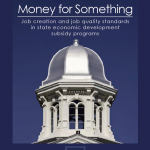 Money for Something: job creation and job quality standards in state economic development subsidy programs
Money for Something: job creation and job quality standards in state economic development subsidy programs
Good Jobs First
Philip Mattera, Thomas Cafcas, Leigh McIlvaine, Andrew Seifter, Kasia Tarczynska
First published December 2011
At a time when unemployment remains high and states and cities are spending an estimated $70 billion a year in the name of economic development, taxpayers are right to ask if such expenditures are creating a substantial number of good jobs. An analysis of major state economic development programs finds that many subsidy programs require little if any job creation. Fewer than half provide any kind of wage standard for the workers at subsidized companies, and fewer than a fourth require any sort of healthcare coverage.
Some individual programs have exemplary safeguards, and the fact that almost every state has some programs with decent job creation or job quality standards makes it clear that these are not “business climate” impediments. Yet no state includes a high level of protection in all of its major subsidy programs, and some states are highly erratic across programs.
These findings come from a careful analysis by Good Jobs First of the most significant subsidy programs in all 50 states and the District of Columbia—238 programs in all, which together cost taxpayers more than $11 billion a year (amounts are not available for 20 of them). The programs include corporate income tax credits (for job creation, capital investment, and/or research & development), cash grants, low‐cost or forgivable loans, enterprise zones, reimbursement for worker training expenses and other types of company‐specific state assistance. (Subsidies that are enabled by state law but whose costs are borne by local governments, such as property tax abatements, are not among the programs examined.)
Download Resource